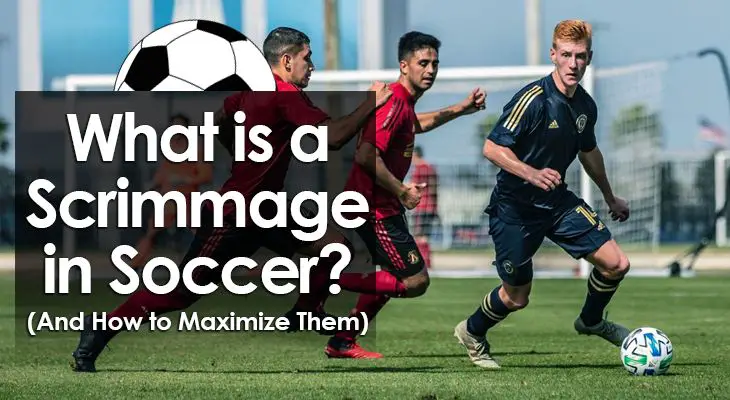What is a Scrimmage in Soccer? (Full Explanation)
An effective soccer practice goes beyond running the same drills over and over again.
Depending on the age group and skill level of your players, it's necessary to adopt a more specialized approach, which helps maximize every player’s individual potential.
An obvious way to achieve this is to create specialized drills for individuals or groups of players.
These drills can be in the form of specific, skill-focused 1v1s, small-sided games, scrimmages, etc.
In this article, we take a closer look at scrimmages in soccer, and how you can maximize them for practice sessions.
What Is A Soccer Scrimmage?
A soccer scrimmage is a practice session where the coach tries to simulate match situations as much as possible to help players prepare for real-game situations.
For instance, when you’re watching a game where a team scores a corner routine that looks practiced, that was most likely done during a scrimmage session.
Scrimmages help players prepare for how to react in various phases of play.
Example:
If the coach decides, based on the knowledge of an upcoming opponent, that it's better for the team to regroup instead of pressing in defensive phases of play, then the best way to practice for it would be in scrimmage sessions.
There, the team can be split into two, with one standing in as the opponent attacking, and the other trying to execute the “regroup” instruction for those defensive phases.
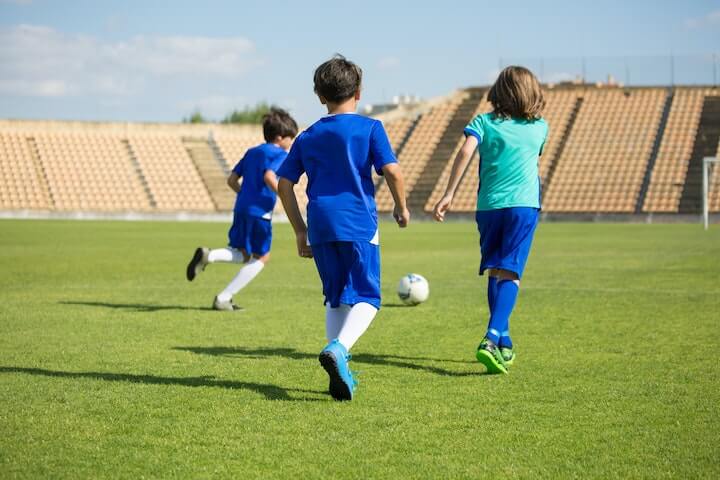
Why You Need Soccer Scrimmages
As mentioned, scrimmage sessions are a great way to prepare for real game situations.
That purpose of giving the players first-hand experience of what to expect in the game is very handy, especially for young players with little experience with how the game works.
Scrimmages with Younger Players
When working with players undergoing their first experience of a soccer game, one of the first things the coach needs to do is teach them the rules.
What better way is there to do this than with a simulation of how a real game would play out?
Scrimmages with Experienced Players
If the coach is working with an experienced team and wants to try out a new formation or style of play, then it would be beneficial to see how the players take to the new approach before the game.
Here, scrimmages help a lot.
Scrimmage sessions can be in the form of friendly, non-competitive matches where a team sets up a game with another team.
Or, the same team can split into two groups on the training ground to play a scrimmage game. For example, the starting XI may play against the reserve team.
The latter situation allows the coach to:
- Review and evaluate the whole squad at once
- Compare the strength of the starting XI with the reserves
- Make any necessary adjustments to the team’s tactic/selection based on the quality of the players in each team
That said, scrimmages are not only done with full-sized teams.
There are different types, let's take a look.
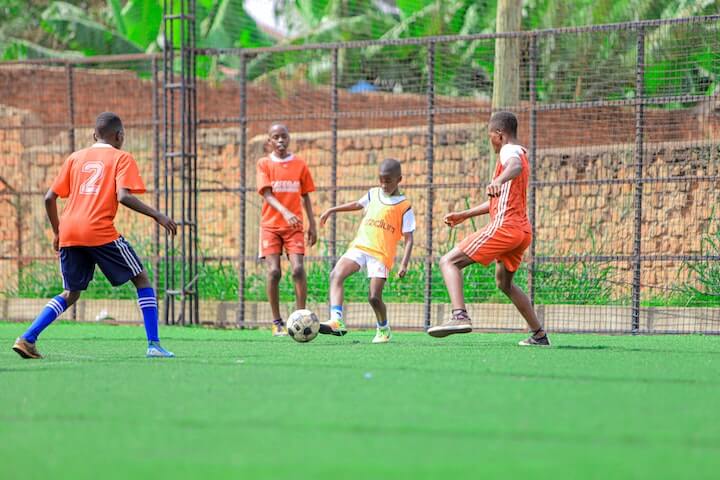
Types of Soccer Scrimmages
1. Full-Game Scrimmages
We've already discussed the full-sized soccer scrimmage game earlier.
It involves two full teams in a 11v11 game, usually playing with the normal soccer rules (but that’s not set in stone).
In cases where the scrimmage involves two separate teams, wearing different-colored jerseys will be enough to distinguish one from the other.
However, if the situation involves a single squad split into two, then it helps to have the players on each team wear differently-colored bibs.
Full-game scrimmages are best for an overall analysis of the team’s strengths and weaknesses.
These enable the coach to test the team’s full strength against opponents of varying skill levels.
Full-game scrimmages also give the coach an opportunity to test players in a variety of positions to gauge their versatility.
2. Small-Sided Scrimmages
A small-sided scrimmage doesn't cover every position in a regular game.
These allow coaches to focus on specific game situations as well as on individual players.
There are usually no more than 10 players in total in a small-sided scrimmages, which means they are often 5v5 games (or less).
Let's say the coach wants to simulate a situation where the team is in a defensive phase of play from an opponent’s goal-kick...
In this situation, there would be little need to have two full teams on the pitch to achieve that.
Small-sided games are most effective for problem-solving.
A full-game scrimmage helps identify the strengths and weaknesses of the team.
On the other hand, small-sided ones are effective for finding solutions to those weaknesses or figuring out how to maximize those strengths.
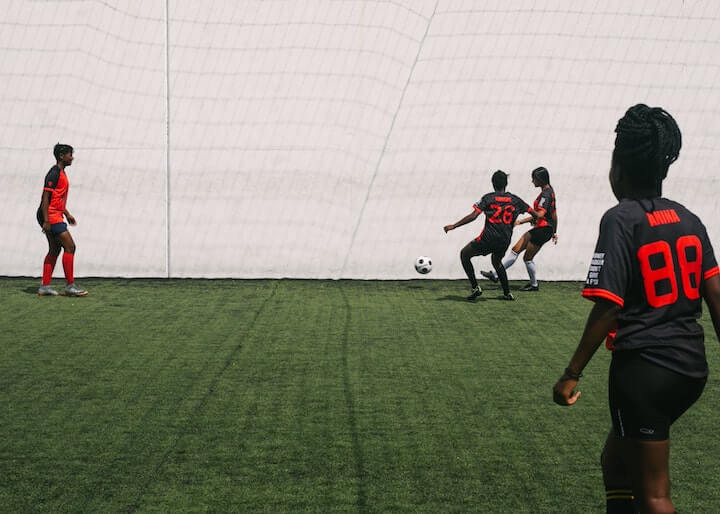
7 Ways To Maximize Soccer Scrimmages
1. Remember To Keep Score
Some would argue that keeping scores is not necessary, but that school of thought should be limited to when dealing with younger kids who just want to have fun.
At more advanced levels, where the players are serious about their development, it can be beneficial to add that extra bit of competitiveness by keeping score.
Adding incentives for the winning teams at practice sessions may also help bring out the players' commitment and effort.
2. Keep The Small-Sided Scrimmage Short
When playing small-sided games such as 5v5s, 3v3s or 4v4s, consider reducing the time spent on each activity.
As mentioned, small-sided scrimmages are most effective for more contextual training and problem-solving...
You don’t need the full extent of a 90-minute game to achieve those.
Additionally, reducing the time for each activity gives you a better assessment of each player's skill level -- instead of having to watch 11 (or 22) players all at once!
3. Introduce New Rules
A full-game scrimmage is usually played with standard rules -- but there are alternatives.
To keep things fresh, fun, and more targeted... consider tweaking the rules a bit to get the most out of your scrimmage.
For instance, depending on the type of pitch used to play, you can introduce a rule that removes set pieces such as throw-ins and corner kicks.
(This rule would be most effective in enclosed spaces with thin -- or non-existent -- sideline spaces.)
It can be useful when the problem you’re trying to solve involves situations where the ball HAS to be in play.
In that case, there would be no benefit to the time lost from stoppages due to set-pieces.
4. Keep Track of Individual Statistics
The influence of data analysis in soccer continues to grow -- and it won’t be long before we see more teams begin to introduce it to practice sessions too.
An obvious advantage of this would be better performance tracking.
Analyzing data would make it easier to gauge the development and application of each player’s efforts on the training ground.
Applying this to your scrimmage sessions can also help gauge player performances better.
Sometimes, the eye test is not as accurate as one would assume, so having that extra bit of information from statistics can be a big help.
5. Record The Session
The rationale behind this is the same as the previous point -- better data analysis.
The information that one can get from watching a live game will vary from what is available from a recorded film.
When you’re watching your scrimmage, it can be easy to miss little details -- especially the ones that happen away from the ball.
Film also gives you an opportunity to study how your team moves when setting up the defense line during defensive phases of play.
Recording the sessions allows you to go back and re-watch everything as many times as you need to get all the important information.
Here, you can re-watch the entire scrimmage as many times as you want, focusing on as many players as you want.
It is simply a much more detailed and accurate “eye-test” approach.
6. Remember To Switch Sides
Gone are the days when defenders were clearly set to defense while attackers were only judged by their contribution to goals.
Nowadays, many coaches expect ALL players to be able to contribute to a good level in BOTH phases of play.
Switching sides during practice helps players develop both their attacking and defending.
The approach here is simple, and here’s an example.
You split your squad into two for a scrimmage, and the task for one of the teams is to execute an instruction for the defensive phase of play while the other team attacks.
In that situation, it would be beneficial to switch sides after a while and let the teams exchange roles.
This will ensure that the whole squad plays both sides of the situation, and everyone (including players not in the starting XI) can execute the instruction in a real game situation to a reasonable level.
7. Introduce Bonus Point Systems
As a follow-up to the scoring system, an extra option would be to introduce bonus points.
Think of it this way, if the team gets a point for achieving the bare minimum, then the bonus point system encourages them to do even more.
This will lead to more effective sessions and faster development as they put in more effort.
Here’s an example:
Imagine a scrimmage where the focus is on creating chances and scoring goals...
When a team scores a goal, they obviously get a point added to their scoreline.
However, you can introduce a bonus point for teams that score a goal after completing an uninterrupted sequence of fifteen (15) passes.
Here, players develop not only their goal-scoring ability but their passing skills as well -- together with other skills like ball handling, first touch, and awareness.
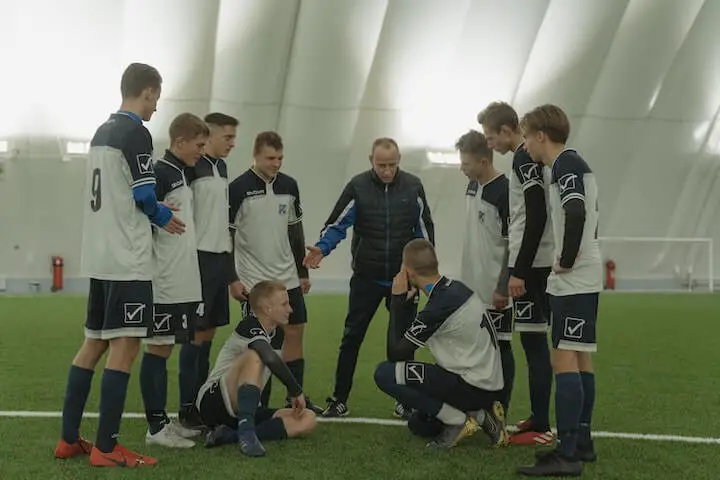
Final Words
All the information here should help you in incorporating scrimmages into your practice sessions.
It's simply a more efficient training philosophy, and benefits far outweigh any disadvantages (not that we know of any!)
Soccer is and will continue to be one of the most important sports in the world, and it will also continue to evolve.
And as it does, it is important to stay up to date with best practices around the world.
This allows you to get the most out of your team as a coach, or the most out of your potential as a player. Remember, flexibility and innovation are key to staying competitive!

